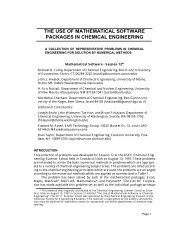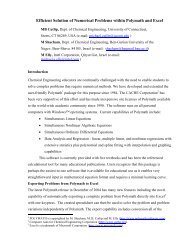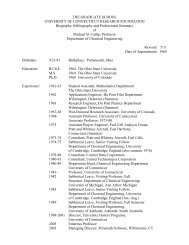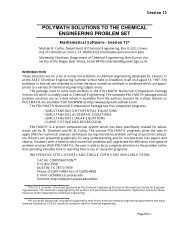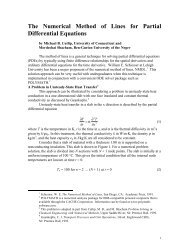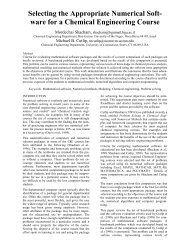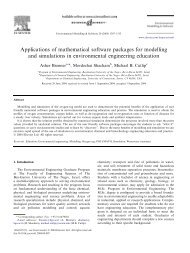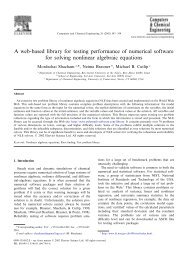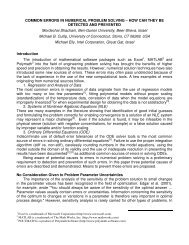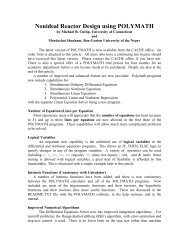Maple Solutions to the Chemical Engineering Problem Set
Maple Solutions to the Chemical Engineering Problem Set
Maple Solutions to the Chemical Engineering Problem Set
Create successful ePaper yourself
Turn your PDF publications into a flip-book with our unique Google optimized e-Paper software.
<strong>Maple</strong> found no less than 8 solutions without much effort. It is easy <strong>to</strong> see, however, that not all of <strong>the</strong><br />
solutions are physically meaningful; some of <strong>the</strong>m contain negative concentrations.<br />
> result[1];<br />
{ C = 0 , C = 0 , C = 0 , C = 0 , C = 0 , C = -.3879574470 , C = -.3207318471<br />
,<br />
C, 0 D, 0 X, 0 Y, 0 Z, 0 B X<br />
C = 1.072193162 , C = 1.136496132 , e = 1.072193162 , K = 2.630000000 , C = .2564288777 , K = 5.<br />
,<br />
D Z R1<br />
R2<br />
C R3<br />
C = .8157642847 , e = 1.136496132 , e = .8157642847 , C = -.7086892941 , C = 1.500000000<br />
,<br />
Y R3<br />
R2<br />
A B, 0<br />
C = 1.500000000 , K = 1.<br />
}<br />
A, 0<br />
R1<br />
while o<strong>the</strong>rs are complex.<br />
> result[2];<br />
{ e = .9256703707 + .1402769617 I , C = 0 , C = 0 , C = 0 , C = 0 , C = 0 , K = 2.630000000<br />
,<br />
R2<br />
C, 0 D, 0 X, 0 Y, 0 Z, 0 R2<br />
K = 5. , C = .9256703707 + .1402769617 I , e = 1.727932631 + .1181659648 I<br />
,<br />
R3 Y<br />
R3<br />
C = 1.727932631 + .1181659648 I , e = .2016941637 − .07686691417 I , C = − .7239762070 − .2171438759 I<br />
,<br />
Z<br />
R1<br />
C<br />
C = − .8022622599 + .02211099693 I , C = − .4296267943 − .04129905063 I<br />
,<br />
X A<br />
C = .3726354656 − .06341004756 I , C = .2016941637 − .07686691417 I , C = 1.500000000<br />
,<br />
B<br />
D<br />
B, 0<br />
C = 1.500000000 , K = 1.<br />
}<br />
A, 0<br />
R1<br />
Only one of <strong>the</strong> solutions is physically meaningful.<br />
> result[8];<br />
{ C = 0 , C = 0 , C = 0 , C = 0 , C = 0 , K = 2.630000000 , K = 5. , C = 1.500000000<br />
,<br />
C, 0 D, 0 X, 0 Y, 0 Z, 0 R2<br />
R3 B, 0<br />
C = 1.500000000 , K = 1. , C = .2474609670 , e = .7011220209 , C = .1766927072 , C = .4241536742<br />
,<br />
A, 0<br />
R1 B R1<br />
X A<br />
C = .7011220209 , C = .3747243049 , C = .5514170121 , e = .3747243049 , e = .5514170121<br />
,<br />
D Z Y R3<br />
R2<br />
C = .1497050089}<br />
C<br />
Note that we did not have <strong>to</strong> rearrange <strong>the</strong> equations in<strong>to</strong> a form more suitable for numerical<br />
computation as was done in <strong>the</strong> Polymath solution. We did not have <strong>to</strong> provide initial guesses of <strong>the</strong><br />
unknown variables, and we did not have <strong>to</strong> work out <strong>the</strong> independent equations since we could do that<br />
with <strong>Maple</strong> as well. Of course, it is possible <strong>to</strong> compute a purely numerical solution using <strong>the</strong> New<strong>to</strong>n's<br />
method package in <strong>the</strong> share library as was done for ano<strong>the</strong>r example in this collection.<br />
><br />
Page 24



